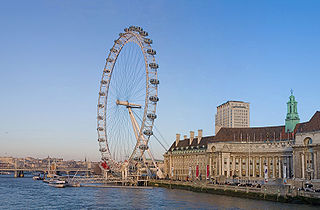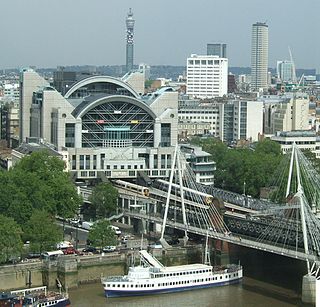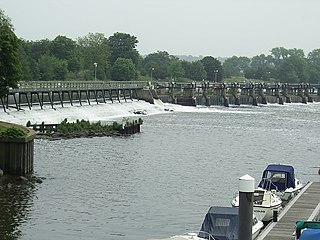
Cleopatra's Kiosk is a small building and shop, on the Victoria Embankment, London, under the Hungerford Bridge. Built in the late 1940s the old kiosk has been replaced by a new futuristic structure.

Cleopatra's Kiosk is a small building and shop, on the Victoria Embankment, London, under the Hungerford Bridge. Built in the late 1940s the old kiosk has been replaced by a new futuristic structure.
In May 1940 Commander Coakley took his two Thames 'little ships' to rescue men stranded on the beaches of Dunkirk. One little ship was lost and the other badly damaged. To enable Commander Coakley to earn a living after the war the Port of London Authority (PLA) rented him a small piece of land on the Victoria Embankment. It was here that Coakley erected a kiosk from which to sell tickets for riverboats. [1]
In 1960 Coakley wished to retire and contacted one of his relatives, Kate Stanton, to enquire if she would be willing to run the kiosk for him. Kate ran it with her other business interests for a year or two, and increased sales substantially. In 1964 Kate's daughter, Julia Stanton, took over the running of Cleopatra's Kiosk and has been there ever since. [2] In 1998 it was reported that the kiosk had not been closed since shortly after the Second World War apart from Christmas Days. [2]
To help construction of the Golden Jubilee pedestrian Bridge (Hungerford Bridge) Westminster City Council at first proposed that the kiosk should be removed and issued a compulsory purchase order [2] but later agreed that the kiosk would be moved to a nearby temporary location to allow the business to continue whilst the footbridge construction works were in progress. Owing to the move, the fabric of the kiosk deteriorated.
It was agreed by Westminster City Council that the area between the base of the brick railway pier and the steps leading from Embankment pier through the listed river wall will be leased to Samuel Alexander Ltd (the owners of the kiosk). A new structure was planned to be designed and constructed on this site. [1]
Following an international architectural design competition held in 2003 by RIBA Competitions, in which over 200 of the world's leading architects competed, the old kiosk was replaced by a new highly modernistic one designed by the Italian firm Bianchini e Lusiardi associati with the work projected to take up to five years. [1] It was actually completed in July 2007 with the cost of the project amounting to £160,000. [3]
The site is located to the north west of the Golden Jubilee Bridge on the Victoria Embankment opposite the Embankment Tube Station.

The South Bank is an entertainment and commercial district in central London, England on the south bank of the River Thames opposite the City of Westminster. It forms a narrow strip of riverside land within the London Borough of Lambeth and the London Borough of Southwark,. As such, the South Bank may be regarded as somewhat akin to the riverside part of an area known previously as Lambeth Marsh and North Lambeth.

Embankment is a London Underground station in the City of Westminster, known by various names during its history. It is served by the Circle, District, Northern and Bakerloo lines. On the Bakerloo line and the Charing Cross branch of the Northern line, the station is between Waterloo and Charing Cross stations; on the Circle and District lines, it is between Westminster and Temple and is in Travelcard Zone 1. The station has two entrances, one on Victoria Embankment and the other on Villiers Street. The station is adjacent to Victoria Embankment Gardens and is close to Charing Cross station, Embankment Pier, Hungerford Bridge, Cleopatra's Needle, the Royal Air Force Memorial, the Savoy Chapel and Savoy Hotel and the Playhouse and New Players Theatres.

Charing Cross railway station is a central London railway terminus between the Strand and Hungerford Bridge in the City of Westminster. It is the terminus of the Southeastern Main Lines to Dover via Ashford and Hastings via Tunbridge Wells. All trains are operated by Southeastern, which provides the majority of commuter and regional services to south-east London and Kent. It is connected to Charing Cross Underground station and is near to Embankment Underground station and Embankment Pier.

Vauxhall Bridge is a Grade II* listed steel and granite deck arch bridge in central London. It crosses the River Thames in a southeast–northwest direction between Vauxhall on the south bank and Pimlico on the north bank. Opened in 1906, it replaced an earlier bridge, originally known as Regent Bridge but later renamed Vauxhall Bridge, built between 1809 and 1816 as part of a scheme for redeveloping the south bank of the Thames. The bridge was built at a location in the river previously served by a ferry.

Westminster is a London Underground station in the City of Westminster. It is served by the Circle, District and Jubilee lines. On the Circle and District lines, the station is between St James's Park and Embankment, and on the Jubilee line it is between Green Park and Waterloo. It is in Travelcard Zone 1. The station is located at the corner of Bridge Street and Victoria Embankment and is close to the Houses of Parliament, Westminster Abbey, Parliament Square, Whitehall, Westminster Bridge, and the London Eye. Also close by are Downing Street, the Cenotaph, Westminster Millennium Pier, the Treasury, the Foreign and Commonwealth Office, and the Supreme Court.

Waterloo Bridge is a road and foot traffic bridge crossing the River Thames in London, between Blackfriars Bridge and Hungerford Bridge and Golden Jubilee Bridges. Its name commemorates the victory of the British, Dutch and Prussians at the Battle of Waterloo in 1815. Thanks to its location at a strategic bend in the river, the bridge offers good views of Westminster, the South Bank and the London Eye to the west, and of the City of London and Canary Wharf to the east.

Victoria Embankment is part of the Thames Embankment, a road and river-walk along the north bank of the River Thames in London, England. Built in the 1860s, it runs from the Palace of Westminster to Blackfriars Bridge in the City of London, and acts as a major thoroughfare for road traffic between the City of Westminster and the City of London.


Chelsea Bridge is a bridge over the River Thames in west London, connecting Chelsea on the north bank to Battersea on the south bank, and split between the City of Westminster, the London Borough of Wandsworth and the Royal Borough of Kensington and Chelsea. There have been two Chelsea Bridges, on the site of what was an ancient ford.

Albert Bridge is a road bridge over the River Thames connecting Chelsea in Central London on the north bank to Battersea on the south. Designed and built by Rowland Mason Ordish in 1873 as an Ordish–Lefeuvre system modified cable-stayed bridge, it proved to be structurally unsound, so between 1884 and 1887 Sir Joseph Bazalgette incorporated some of the design elements of a suspension bridge. In 1973 the Greater London Council added two concrete piers, which transformed the central span into a simple beam bridge. As a result, today the bridge is an unusual hybrid of three different design styles. It is an English Heritage Grade II* listed building.

The Tideway is a part of the River Thames in England which is subject to tides. This stretch of water is downstream from Teddington Lock. The Tideway comprises the upper Thames Estuary including the Pool of London.

Cast-iron architecture is the use of cast iron in buildings and objects, ranging from bridges and markets to warehouses, balconies and fences. Refinements developed during the Industrial Revolution in the late 18th century made cast iron relatively cheap and suitable for a range of uses, and by the mid-19th century it was common as a structural material, and particularly for elaborately patterned architectural elements such as fences and balconies, until it fell out of fashion after 1900 as a decorative material, and was replaced by modern steel and concrete for structural purposes.

Embankment Pier is a pier on the River Thames in City of Westminster, London. It is located on the north bank of the river, immediately next to the Hungerford Bridge and directly outside the river entrance to Embankment Underground station. It is also conveniently close to Charing Cross railway station.
Kiosk is a small enclosed structure, often freestanding, open on one or both sides or with a window, used as a booth to sell newspapers, tobacco, coffee, food and drink, etc. or to dispense information.
Thomas Page was a British architect and civil engineer who was responsible for the design and construction of many bridges, including Westminster Bridge and the first Chelsea Bridge


Boadicea and Her Daughters is a bronze sculptural group in London representing Boudica, queen of the Celtic Iceni tribe, who led an uprising in Roman Britain. It is located to the north side of the western end of Westminster Bridge, near Portcullis House and Westminster Pier, facing Big Ben and the Palace of Westminster across the road. It is considered the magnum opus of its sculptor, the English artist and engineer Thomas Thornycroft. Thornycroft worked on it from 1856 until shortly before his death in 1885, sometimes assisted by his son William Hamo Thornycroft, but it was not erected in its current position until 1902.

Dolphin lamp standards provide electric light along much of the Thames Embankment in London, United Kingdom. Two stylised dolphins or sturgeons writhe around the base of a standard lamp post, supporting a fluted column bearing electric lights in an opaque white globe, topped by a metal crown. Many of the lamps are mounted on granite plinths.

The statue of James Outram, a work by Matthew Noble, stands in Whitehall Gardens in London, south of Hungerford Bridge. It is a Grade II listed structure.
